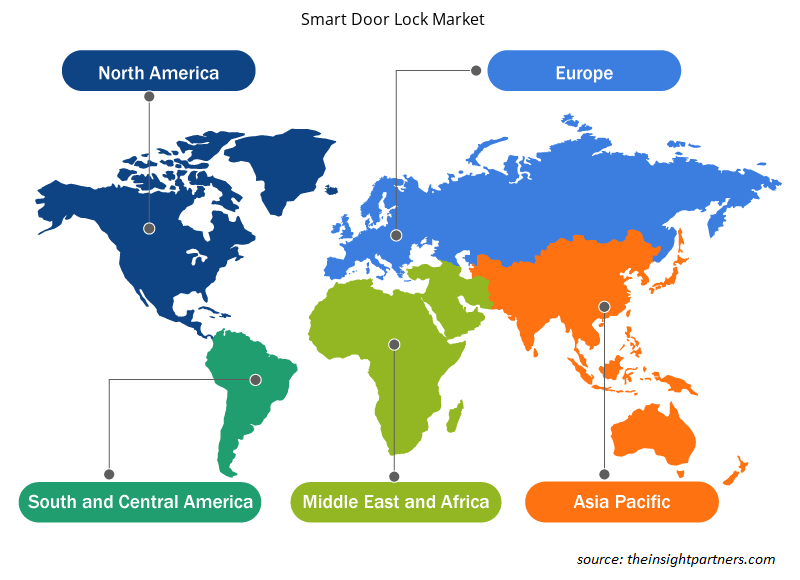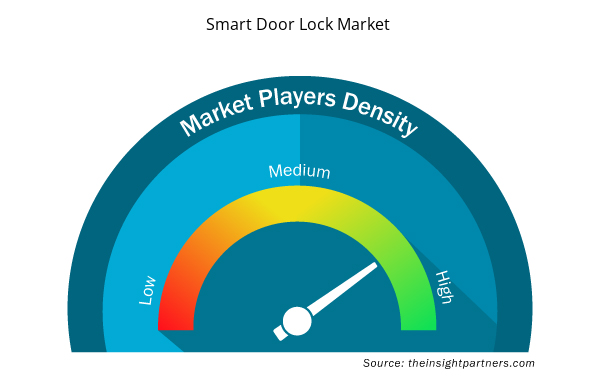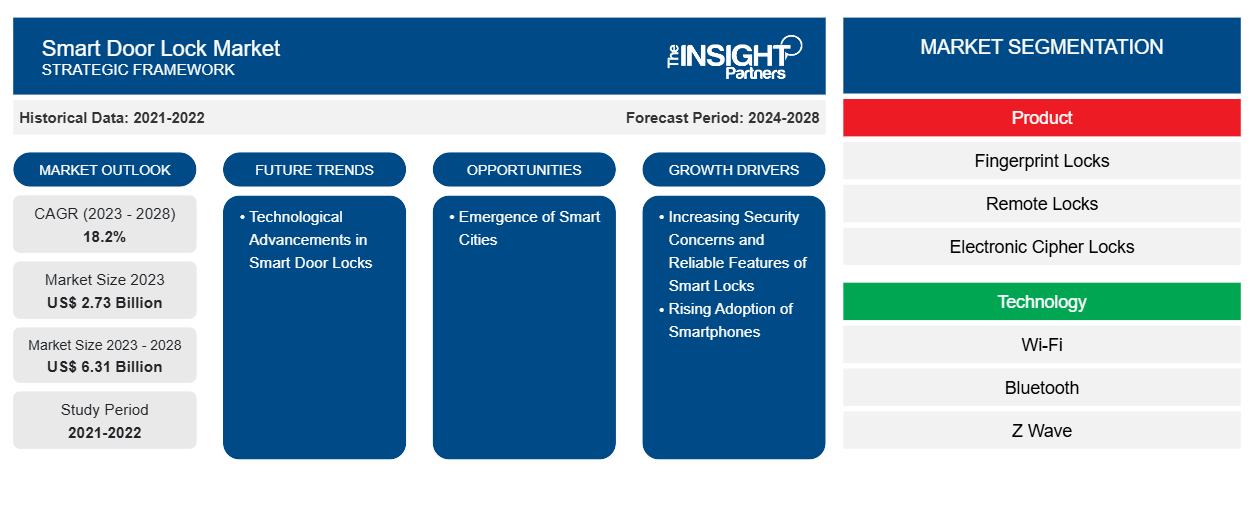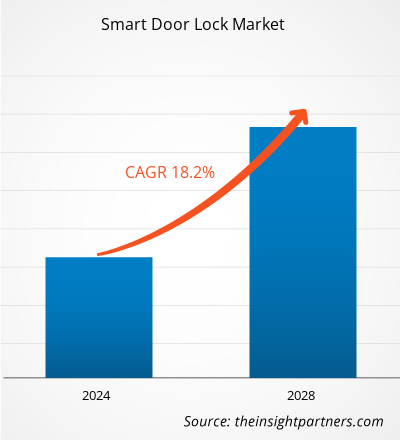[研究报告] 智能门锁市场规模预计将从 2023 年的 27.3305 亿美元增长到 2028 年的 63.0913 亿美元;预计 2023 年至 2028 年的复合年增长率为 18.2%。
智能门锁是一种先进的锁系统,无需实体钥匙即可安全便捷地进入建筑物或房间。智能门锁可以通过生物识别、数字代码或无线信号等电子身份验证方法锁定或解锁。智能门锁用于住宅、商业建筑、酒店业、教育设施、医疗保健设施等。物联网 (IoT) 的日益流行和实施,以及对安全和隐私的日益关注,正在推动全球智能家居安全设备的采用。消费者对先进安全解决方案优势的认识不断提高,预计将推动智能门锁市场的发展
过去几年,全球智能手机用户数量的激增导致智能门锁的部署增加。这些锁具有简单的用户界面和方便的使用方式。人们对安全家居解决方案的认识不断提高,智能手机等智能设备的发展,消费者可支配收入的增加,安全威胁的增加,智能城市的发展以及蓬勃发展的互联网连接进一步促进了智能门锁市场的增长。智能门锁集成了蓝牙、Wi-Fi、Z Wave、RFID 和 NFC 等通信技术。
定制此报告以满足您的需求
您可以免费定制任何报告,包括本报告的部分内容、国家级分析、Excel 数据包,以及为初创企业和大学提供优惠和折扣
- 获取此报告的关键市场趋势。这个免费样品将包括数据分析,从市场趋势到估计和预测。
COVID-19 疫情对全球智能门锁市场的影响分析
2020 年,COVID-19 疫情在全球经济高峰期爆发,给全球经济造成了巨大影响,这场危机阻碍了制造业的商业活动。在 COVID-19 疫情爆发之前,由于生活水平不断提高,住宅和商业领域的智能门锁市场正在经历大幅增长。半导体和电子等多个行业在项目开发、出货、制造和新产品研发方面面临挑战。然而,由于封锁和社交疏离措施,对非接触式产品的需求增加,使智能门锁市场受益。lockdown and social distancing measures benefitted the smart door lock market.
新冠疫情对不同行业的供应链运营、资本支出、生产和长期战略产生了不利影响。由于各国政府采取的隔离措施,制造商在开展业务发展活动时面临困难,导致其日常运营发生变化。此外,疫情迫使企业重组业务模式,专注于实现规模经济的战略。这些因素阻碍了智能门锁市场在 2020 年的发展。
市场洞察 – 智能门锁市场分析
智能门锁的技术进步将在未来几年推动市场增长
智能门锁市场中的各种参与者都在其智能锁中融入 人工智能(AI)、机器学习 (ML) 和其他类似技术。集成 AI 和 ML 的门锁通过跟踪谁打开和关闭门来确保更好的家庭安全。此外,这些锁可以更好地控制谁可以锁门和解锁门。它们还允许用户在离开或接近家时自动锁门或解锁门。集成 AI 或 ML 的锁可能有助于识别闯入或锁篡改企图。因此,先进技术的整合为智能门锁市场参与者提供了丰厚的增长机会。
智能门锁市场各参与者都在推出融合先进技术的新产品,以满足对智能门锁市场日益增长的需求。2022 年 12 月,云米推出了云米 AI 智能门锁 Super 2E。这款全自动智能门锁支持六种解锁方式:指纹、密码、虚拟密码、临时密码、门卡和钥匙。它具有 AI 自学习技术,使用起来会变得更加灵敏。2023 年 4 月,Geonfino 推出了三款新智能锁——Geonfino G4 Pro 指纹门锁、Geonfino G4 Pro+G2 智能锁和 Geonfino S1 Pro 智能锁——采用六合一解锁方式,包括指纹、应用程序、密码、IC 卡、物理钥匙和网关控制。2023 年 2 月,小米推出了其新的小米智能门锁 M20 系列。这款新型号 Smart Guardian Can See 配备了集成的猫眼摄像头和显示屏,可为用户提供前门的实时全面视图。此外,该型号还配备了门铃功能,为用户提供了更多便利。因此,在预测期内,采用新技术增强安全性的智能锁的推出将进一步推动智能门锁市场的增长。
智能门锁市场区域洞察
Insight Partners 的分析师已详细解释了预测期内影响智能门锁市场的区域趋势和因素。本节还讨论了北美、欧洲、亚太地区、中东和非洲以及南美和中美洲的智能门锁市场细分和地理位置。

- 获取智能门锁市场的区域特定数据
智能门锁市场报告范围
| 报告属性 | 细节 |
|---|---|
| 2023 年的市场规模 | 27.3亿美元 |
| 2028 年市场规模 | 63.1亿美元 |
| 全球复合年增长率(2023 - 2028) | 18.2% |
| 史料 | 2021-2022 |
| 预测期 | 2024-2028 |
| 涵盖的领域 | 按产品
|
| 覆盖地区和国家 | 北美
|
| 市场领导者和主要公司简介 |
|
市场参与者密度:了解其对商业动态的影响
智能门锁市场正在快速增长,这得益于终端用户需求的不断增长,而这些需求又源于消费者偏好的不断变化、技术进步以及对产品优势的认识不断提高等因素。随着需求的增加,企业正在扩大其产品范围,进行创新以满足消费者的需求,并利用新兴趋势,从而进一步推动市场增长。
市场参与者密度是指在特定市场或行业内运营的企业或公司的分布情况。它表明在给定市场空间中,相对于其规模或总市场价值,有多少竞争对手(市场参与者)存在。
在智能门锁市场运营的主要公司有:
- 亚萨合莱公司
- 安朗吉恩公司
- MIWA锁业有限公司
- Spectrum Brands 控股公司
- 齐格邦
免责声明:上面列出的公司没有按照任何特定顺序排列。

- 了解智能门锁市场顶级关键参与者概况
不同的智能门锁市场参与者正在推出先进的智能门锁,以实现先进的安全目的,具体如下:
- 2023年4月,智能门锁制造商Geonfino推出了三款智能门锁,采用独特的六合一解锁方式,确保最大程度的安全性和便利性。智能门锁具有生物识别功能和语音控制功能。
- 2023年2月,小米推出了一款集成猫眼摄像头和显示屏的智能门锁,可为用户提供实时全方位的门前视野。
公司简介:
- 阿德尔营销(马)有限公司
- 安朗吉公司
- 亚萨合莱
- 广东力维智能锁业有限公司
- 霍尼韦尔国际公司
- 光谱品牌
- 洛星科技有限公司
- 玛斯特锁公司
- Miwa Lock 公司,Zigbang
- 历史分析(2 年)、基准年、预测(7 年)及复合年增长率
- PEST 和 SWOT 分析
- 市场规模价值/数量 - 全球、区域、国家
- 行业和竞争格局
- Excel 数据集


- Genetic Testing Services Market
- Sports Technology Market
- Lyophilization Services for Biopharmaceuticals Market
- Fish Protein Hydrolysate Market
- Trade Promotion Management Software Market
- Mobile Phone Insurance Market
- Bioremediation Technology and Services Market
- Equipment Rental Software Market
- Vision Guided Robotics Software Market
- Medical Audiometer Devices Market

Report Coverage
Revenue forecast, Company Analysis, Industry landscape, Growth factors, and Trends

Segment Covered
This text is related
to segments covered.

Regional Scope
North America, Europe, Asia Pacific, Middle East & Africa, South & Central America

Country Scope
This text is related
to country scope.
常见问题
APAC is anticipated to grow with the highest CAGR over the forecast period.
The growing security concerns have raised the demand for locking devices enabled with modern technologies such as biometric sensors, Bluetooth, and Wi-Fi to safeguard properties. Smart locks also confer owners a remote control over access to their properties. Thus, they can lock or unlock the door from anywhere using their smartphones. Users having children or pets at home can use a remote access feature to let them in or out of the house without giving them a key.
The US held the largest market share in 2022, followed by China.
The smart door lock market is expected to reach US$ 6,309.13 Mn by 2028.
The country anticipated to grow with the highest CAGR are US, Germany, and China.
The key players holding majority shares in the smart door lock market are ASSA ABLOY, Allegion plc, MIWA Lock Co, Spectrum Brands, Inc., and Zigbang.
Various market players incorporate artificial intelligence (AI), machine learning (ML), and similar technologies in their smart locks. AI- and ML-integrated door locks ensure better home security by tracking who opens and closes the doors. Further, these locks provide greater control over who can lock and unlock particular doors.
The smart door lock market is estimated to be US$ 2,733.05 Mn million in 2023 and is expected to grow at a CAGR of 18.2% from 2023 to 2028.
Trends and growth analysis reports related to Electronics and Semiconductor : READ MORE..
The List of Companies - Smart Door Lock Market
- Assa Abloy AB
- Allegion Plc
- MIWA LOCK Co Ltd
- Spectrum Brands Holdings Inc
- Zigbang
- Honeywell International Inc
- Master Lock Company LLC
- Locstar Technology Co Ltd
- Guangdong Level Intelligent Lock Industrial Co Ltd
- ADEL Marketing (M) Sdn Bhd
The Insight Partners performs research in 4 major stages: Data Collection & Secondary Research, Primary Research, Data Analysis and Data Triangulation & Final Review.
- Data Collection and Secondary Research:
As a market research and consulting firm operating from a decade, we have published and advised several client across the globe. First step for any study will start with an assessment of currently available data and insights from existing reports. Further, historical and current market information is collected from Investor Presentations, Annual Reports, SEC Filings, etc., and other information related to company’s performance and market positioning are gathered from Paid Databases (Factiva, Hoovers, and Reuters) and various other publications available in public domain.
Several associations trade associates, technical forums, institutes, societies and organization are accessed to gain technical as well as market related insights through their publications such as research papers, blogs and press releases related to the studies are referred to get cues about the market. Further, white papers, journals, magazines, and other news articles published in last 3 years are scrutinized and analyzed to understand the current market trends.
- Primary Research:
The primarily interview analysis comprise of data obtained from industry participants interview and answers to survey questions gathered by in-house primary team.
For primary research, interviews are conducted with industry experts/CEOs/Marketing Managers/VPs/Subject Matter Experts from both demand and supply side to get a 360-degree view of the market. The primary team conducts several interviews based on the complexity of the markets to understand the various market trends and dynamics which makes research more credible and precise.
A typical research interview fulfils the following functions:
- Provides first-hand information on the market size, market trends, growth trends, competitive landscape, and outlook
- Validates and strengthens in-house secondary research findings
- Develops the analysis team’s expertise and market understanding
Primary research involves email interactions and telephone interviews for each market, category, segment, and sub-segment across geographies. The participants who typically take part in such a process include, but are not limited to:
- Industry participants: VPs, business development managers, market intelligence managers and national sales managers
- Outside experts: Valuation experts, research analysts and key opinion leaders specializing in the electronics and semiconductor industry.
Below is the breakup of our primary respondents by company, designation, and region:

Once we receive the confirmation from primary research sources or primary respondents, we finalize the base year market estimation and forecast the data as per the macroeconomic and microeconomic factors assessed during data collection.
- Data Analysis:
Once data is validated through both secondary as well as primary respondents, we finalize the market estimations by hypothesis formulation and factor analysis at regional and country level.
- Macro-Economic Factor Analysis:
We analyse macroeconomic indicators such the gross domestic product (GDP), increase in the demand for goods and services across industries, technological advancement, regional economic growth, governmental policies, the influence of COVID-19, PEST analysis, and other aspects. This analysis aids in setting benchmarks for various nations/regions and approximating market splits. Additionally, the general trend of the aforementioned components aid in determining the market's development possibilities.
- Country Level Data:
Various factors that are especially aligned to the country are taken into account to determine the market size for a certain area and country, including the presence of vendors, such as headquarters and offices, the country's GDP, demand patterns, and industry growth. To comprehend the market dynamics for the nation, a number of growth variables, inhibitors, application areas, and current market trends are researched. The aforementioned elements aid in determining the country's overall market's growth potential.
- Company Profile:
The “Table of Contents” is formulated by listing and analyzing more than 25 - 30 companies operating in the market ecosystem across geographies. However, we profile only 10 companies as a standard practice in our syndicate reports. These 10 companies comprise leading, emerging, and regional players. Nonetheless, our analysis is not restricted to the 10 listed companies, we also analyze other companies present in the market to develop a holistic view and understand the prevailing trends. The “Company Profiles” section in the report covers key facts, business description, products & services, financial information, SWOT analysis, and key developments. The financial information presented is extracted from the annual reports and official documents of the publicly listed companies. Upon collecting the information for the sections of respective companies, we verify them via various primary sources and then compile the data in respective company profiles. The company level information helps us in deriving the base number as well as in forecasting the market size.
- Developing Base Number:
Aggregation of sales statistics (2020-2022) and macro-economic factor, and other secondary and primary research insights are utilized to arrive at base number and related market shares for 2022. The data gaps are identified in this step and relevant market data is analyzed, collected from paid primary interviews or databases. On finalizing the base year market size, forecasts are developed on the basis of macro-economic, industry and market growth factors and company level analysis.
- Data Triangulation and Final Review:
The market findings and base year market size calculations are validated from supply as well as demand side. Demand side validations are based on macro-economic factor analysis and benchmarks for respective regions and countries. In case of supply side validations, revenues of major companies are estimated (in case not available) based on industry benchmark, approximate number of employees, product portfolio, and primary interviews revenues are gathered. Further revenue from target product/service segment is assessed to avoid overshooting of market statistics. In case of heavy deviations between supply and demand side values, all thes steps are repeated to achieve synchronization.
We follow an iterative model, wherein we share our research findings with Subject Matter Experts (SME’s) and Key Opinion Leaders (KOLs) until consensus view of the market is not formulated – this model negates any drastic deviation in the opinions of experts. Only validated and universally acceptable research findings are quoted in our reports.
We have important check points that we use to validate our research findings – which we call – data triangulation, where we validate the information, we generate from secondary sources with primary interviews and then we re-validate with our internal data bases and Subject matter experts. This comprehensive model enables us to deliver high quality, reliable data in shortest possible time.


 获取此报告的免费样本
获取此报告的免费样本